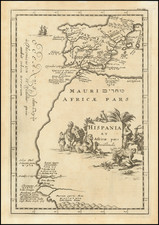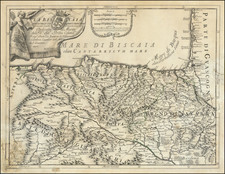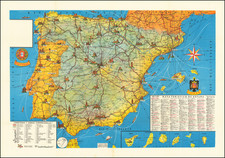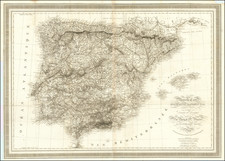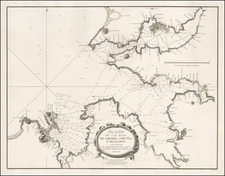Fantastic Depiction of a Symbol of the Catalonian Independence Movement
Striking view of Montserrat and the Abby of St. Mary, near Barcelona. This Catalonian abbey is located high in the Pyrenean foothills, nestled below striking hills composed of large grey boulders.
This copperplate engraving magnificently shows the many religious sites up and down Montserrat. Various religious orders are shown and named, and pilgrims can be seen throughout the view.
Considered one of the most important religious sites of Europe at the time, the consecrated buildings are built around a statue of the Virgin Mary that was found in the ninth century. This began a new cult, and the site was managed by several different orders over its long history. In addition to the Abbey, fraternal orders and a basilica are located on the Montserrat.
Later in the abbey's history, the site became a refuge for opponents of the Franco regime. As such, it has now become a symbol of Catalonian independence.
The verso includes an extensive description of Montserrat and its abbey. It reads as follows:
Mont-Serrat is a mountain, or rather a rock, situated in the kingdom of Spain in the Province of Catalonia to the northeast of Barcelona, and seven leagues and a half from this city, which, in reality, are closer to a dozen [leagues]. It is a devotional site and one of the greatest in Europe. From the summit, you can see very well Barcelona and even the islands of Majorca and Minorca.
The convent of Montserrat is on top of this mountain, between high rocks, which are very close to one another. . .
The text goes on to describe the order of St. Benedict and the population and governance of the convent. The text also tells of a golden crown located at this convent, which appears to be a mythical reference without any modern-day sources. If this crown had existed, it may have been destroyed during the sacking of the convent by Napoleon's troops.
Nicholas de Fer (1646-1720) was the son of a map seller, Antoine de Fer, and grew to be one of the most well-known mapmakers in France in the seventeenth century. He was apprenticed at twelve years old to Louis Spirinx, an engraver. When his father died in 1673, Nicholas helped his mother run the business until 1687, when he became the sole proprietor.
His earliest known work is a map of the Canal of Languedoc in 1669, while some of his earliest engravings are in the revised edition of Methode pour Apprendre Facilement la Geographie (1685). In 1697, he published his first world atlas. Perhaps his most famous map is his wall map of America, published in 1698, with its celebrated beaver scene (engraved by Hendrick van Loon, designed by Nicolas Guerard). After his death in 1720, the business passed to his sons-in-law, Guillaume Danet and Jacques-Francois Benard.











![[Cadiz] Isle Ville et Port De Cadis en Espagne de la Province d'Andalousie a 36.D. de Latitude et 12 Degrez 45 Minutes de Longitude](https://storage.googleapis.com/raremaps/img/small/62354.jpg)
